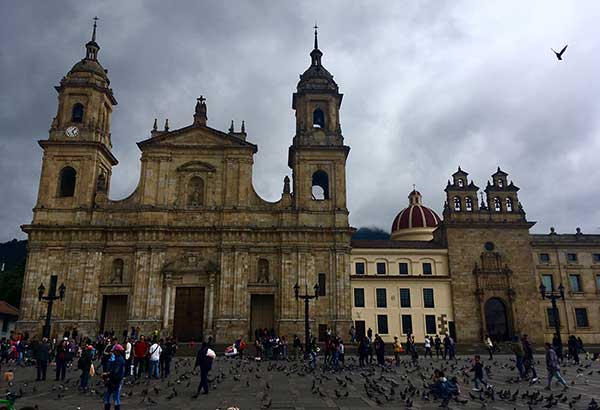Bogotá: Graffiti City

The Primatial Cathedral of Bogotá, officially the Metropolitan Cathedral Basilica of the Immaculate Conception, facing the historic Bolivar Square in central Bogotá. The plaza, frequented by tourists feeding pigeons, features a statue of South American “liberator” Simon Bolivar.
MANILA, Philippines — What happens when you turn an entire city into a canvas? For Colombia’s capital city of Bogotá, it means bringing cultural revolution to the next level.
Often dubbed as a haven for graffiti artists, Bogotá offers a unique experience to millions of tourists who visit the country every year.
Indeed, one does not need to look for a museum to have an idea of what contemporary art is for this South American nation. All you have to do is look around.
Unlike in most cities where unauthorized painting in public spaces is considered a crime, in Bogotá it is even encouraged by the city government. The result: an unpredictable mix of scrawls and images that is nothing short of magical.
Bogotá’s graffiti revolution traces its roots to an unfortunate incident in 2011, when the police shot dead 16 year-old Diego Felipe Becerra as they tried to apprehend him while he was painting his signature Felix the Cat image in an underpass in the city.
His death sparked massive protests in the city, which later resulted in the local government allowing graffiti painting in the city, except in several pre-identified buildings and monuments. Then mayor Gustavo Petro even went further and hired local graffiti artists to paint in major locations in the city.
Six years later, the city boasts thousands of street art, from small texts in obscure streets to enormous images painted on the side of buildings in central Bogotá.
Imagination, it seems, is the limit for the street artists who were given the free pass to express themselves.
A far cry from the Colombia that is being portrayed in the Western media, Bogotá – while still plagued by common crimes such as theft and robbery – showcases itself as a safe haven for tourists and locals alike.
Mayor Enrique Peñalosa, during the recent One Young World summit attended by over 1,300 youth delegates worldwide, touted a new dawn for Bogotá and the rest of Colombia following the historic signing of the peace deal with the revolutionary forces.
The newfound peace, he says, offers an opportunity for the world to experience what their country has to offer.
At over 8,600 feet above sea level, in one of the higher plateaus of the Andes mountain range of South America, Bogotá was founded by the Spanish conquistadores in 1538 as the capital city of its settlement in northern South America.
Prior to that, it was known as Bacatá by the indigenous people known as Muisca.
With its centuries-long history, one would not have a shortage of activities to do in this South American city.
Aside from street art, visitors can explore the numerous museums in the city, including the famed Museo del Oro that houses the largest collection of gold artifacts in the world. Inside, the famed mythical golden city of El Dorado – supposedly located in Colombia – comes to mind.
Just a few blocks from the Gold Museum is the Botero Museum, which houses over 120 art pieces of celebrated Colombian artist Fernando Botero, who is known for his signature style that features “fat” subjects.
The museum also exhibits dozens of artworks from Botero’s private collection, including pieces by Pablo Picasso, Claude Monet and Henri Matisse.
Nearby is the Gabriel García Márquez Cultural Center, which features a massive bookstore and an art gallery.
Márquez, a Nobel Prize laureate in literature, traces his roots from Colombia and is known for novels such as One Hundred Years of Solitude and Love in the Time of Cholera.
Meanwhile, at the center of the city’s historical area is Plaza Bolivar, named after the Venezuelan political leader who played a significant role in the establishment of independent nations in South America, including Colombia, from the Spanish rule.
Surrounding the square is the National Capitol, the Palace of Justice, the Palacio Liévano (mayor’s office) and the imposing Primatial Cathedral of Colombia.
The Cathedral, which is the seat of the Archbishop of Bogotá, is just one of the dozens of churches scattered in the city. Like most of Latin America, Colombians are mainly Roman Catholic.
Aside from the Cathedral, another popular church among tourists is the shrine of El Señor Caído (The Fallen Lord) located on the peak of Monserrate, a mountain just within the city limits.



















